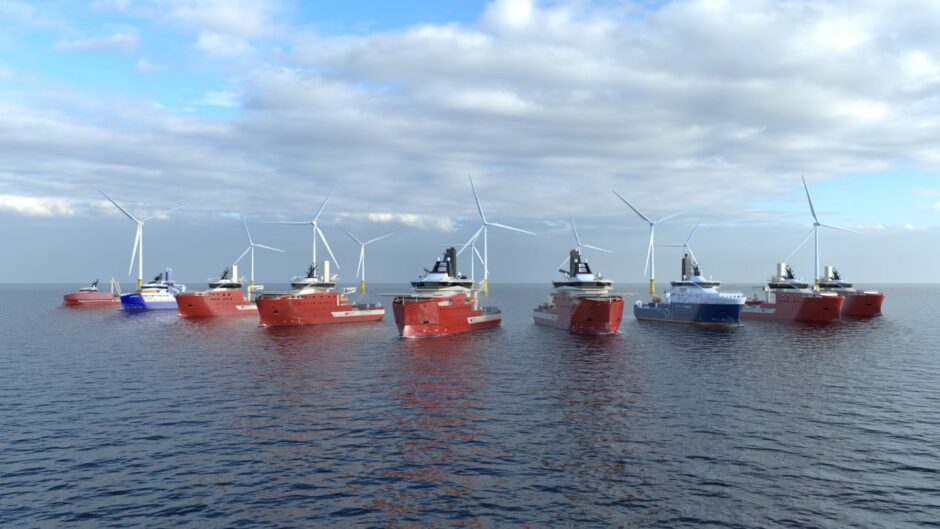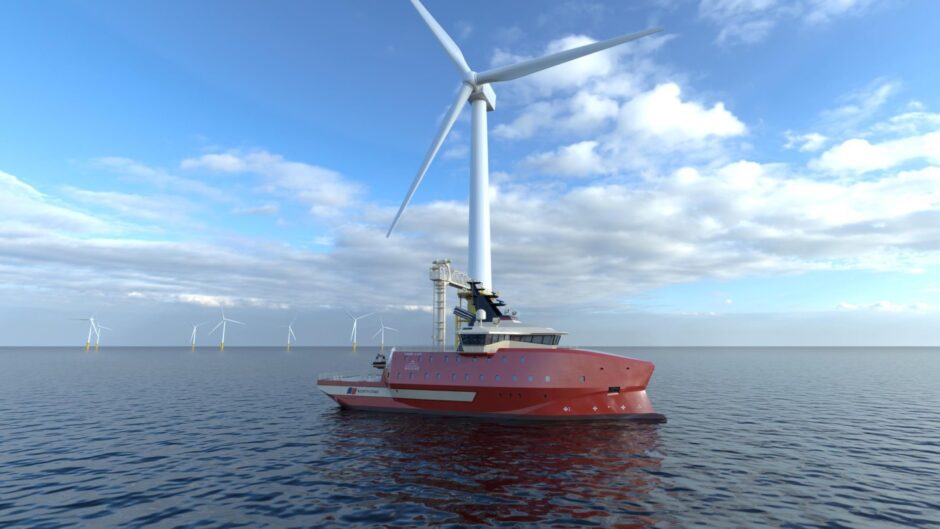
Traditionally, the maritime industry has been known as conservative when it comes to embracing innovation.
However, this is steadily changing, with more companies in the sector adopting digital and digitised solutions to drive efficiency, enhance customer experience and stay competitive in an increasingly technology-driven marketplace.
For those supporting the energy sector, and specifically the energy transition, embracing this transformation to achieve their own green objectives is also a critical element to grow and elevate the industry as a whole.
For offshore infrastructure support vessel operators, ensuring reliability and longevity of their fleet can come via two avenues; building highly efficient ships to meet different operational requirements, and retrofitting existing fleets with technologies that future proof and prepare them for a digital future.
This is particularly true of North Star, which is progressing its decarbonisation strategy across its vessel fleet.
This includes its emergency response and rescue vessels (ERRV) fleet that has been servicing the UK North Sea’s conventional energy sector for the past five decades, and its more recent investment in its service operations vessels (SOV), designed for the renewables market.
These hybrid-powered high-performance ships provide premium comfort and accommodation for the offshore wind technicians as they carry out essential maintenance activities for weeks at a time in field, and act as a warehouse and logistics hub.
Investment in the latest proven technologies is key to North Star’s core strategy and ambition to add 40 hybrid SOVs to its fleet by 2040.
The gap for achieving this target is steadily closing with another two newbuilds for long-term charter ordered this year so far, taking the company’s running total to eight offshore wind ships either already delivered for long-term charter or currently under construction.
This includes three of four delivered and operating at Dogger Bank, one for Siemens Gamesa Renewable Energy at East Anglia THREE in the Southern North Sea, and another for EnBW to service the He Dreiht wind farm off the coast of Germany.
Collaboration driving change
Technology partnerships are increasingly important to ensure North Star’s vessels are designed to the highest standards, with equipment and systems working symbiotically to improve efficiencies during offshore operations.
Through the adoption of a collaborative approach when considering each stage of a vessel’s lifecycle, ship construction and system design is evolving at pace to support emerging industries by redefining the “norm” and what is achievable.
Alongside one of the world’s major designers and shipbuilders of specialised vessels, VARD, North Star developed its state-of-the-art hybrid-propulsion SOV to provide a greener and more efficient vessel to the offshore wind sector.
To reduce harmful emissions during operations, it incorporates features such as “Energy Storage Systems” lithium-C batteries, whilst pairing with highly efficient Tier III Dual fuel capable engines.
These features deliver high reliability and low emissions when carrying out offshore wind maintenance activities within a challenging offshore environment.
To drive high performance and efficiencies, its designs also include highly effective main propulsion units, such as Voith Schneider eVSP and are prepared for the potential future use of methanol as a primary fuel.
By incorporating these capabilities, the SOVs embrace the advances made in vessel design, improving fuel efficiencies by preparing for future fuels through innovative technology, that will be supported throughout its supply chain to meet not only its own internal objectives but industry decarbonisation goals as it progresses its transition to net zero.
A collaborative approach was also key in designing its hybrid-powered daughter craft (DC), resulting in the first workboat of its kind being made available for Europe’s offshore wind market.
This achievement was made possible through its partnerships with Southampton-based naval architects Chartwell Marine.
These smaller vessels are housed onboard the SOV and utilised to safely transfer crews to a specific wind turbine when the SOV is employed in close quarter Walk-to-Work gangway operations using its inbuilt technology to safely transfer cargo and persons to the turbine.
Each SOV is designed to meet its client requirements in size and in capability, it has four different VARD SOV designs currently deployed or planned for windfarm activities across the UK and Europe.
This includes its first two larger Commissioning-SOVs, with a design that can easily handle the complex and demanding tasks associated with the early phase of offshore wind projects.
Offshore wind is a dynamic market that demands continuous focus and entrepreneurial vision, the next logical step in SOVs for the renewables markets, is the development of the Midi-SOV.
The Midi-SOV solution
Another challenge the sector faces is the difficulty of crew transfer vessels (CTVs) accessing offshore wind sites, particularly during adverse weather conditions.
North Star is the first to develop the Midi-SOV having leveraged its industry partnerships with VARD and Chartwell Marine to offer an auxiliary solution which sidesteps this restriction.
Purposely designed to bridge the gap between CTVs and SOVs, it offers the same enhanced comfort and workability as North Star’s existing tonnage, but also provides a cost-effective alternative to a full-scale SOV.
Optimised through the effective use of operational data, the Midi-SOV meets the specific needs of offshore wind developers and complements its existing fleet.
The Midi-SOV aims to increase efficiency by providing elevated onsite endurance levels when compared to some CTV models used during winter months.
By providing a diverse range of purpose-built ships, North Star is able to provide increased access to windfarm sites situated within extremely challenging offshore environments, making them accessible and providing windfarm developers more options as they pursue new licenses throughout these challenging regions.
The digital solutions of today
Collaborating with leading technology partners to create reliable, expertly designed support vessels remains integral, but it’s just one piece of the puzzle.
True performance management comes from the use of digital technologies that provide a forensic insight to improving in-field operational capabilities, real time performance management through digital twinning is a tool essential for unlocking greater efficiency and vessel reliability.
Recognition of digital technology and digital insights is widespread across the sector, with organisations like DNV often leading the conversation and emphasising the important role that partnerships between technology providers and the maritime sector play in harnessing the potential within the digital space.
To meet industry requirements and secure its needs within the supply chain for any energy transition, there are a variety of digital technologies that can be adopted, such as the use of artificial intelligence (AI) software, which learns from data collecting systems that ultimately produces prescriptive outputs through advanced enterprise resource planning (ERP) systems.
Having a comprehensive, integrated approach to technology development, by investing substantial resources into equipping its SOVs with a range of data-driven technologies to support enhanced decision making. Two of systems, developed by Jungle AI and MO4, have been introduced to its SOV fleet which provides complimenting data streams.
Jungle AI’s technology provides a forensic insight into mission critical systems that are integral to the running of the vessel.
With this system on board, an internal “visual” of the systems actual performance is collected and compared with its designed capability.
The data once collected and categorised acts as a catalyst to drive interaction and intervention with any operational issues before they interrupt offshore activities. This type of system allows vessels to move away from a periodical maintenance regime to prescriptive maintenance, supporting efficiencies and improving safety by providing insight and the ability to mitigate potentially serious system issues, that would have been encountered by its crews.
In 2022, North Star also signed a 10-year contract with MO4 for its new propriety digital twin and AI decision support software package.
Much like Jungle AI’s software, MO4’s technology provides predictive support to help drive efficiencies across the fleet including lowering carbon emissions through reduced fuel usage.
This digital solution gathers data on influential areas such as weather fronts, workloads, work routes and drop-off schedules to help the crew make informed decisions.
As the full SOV fleet continues to be monitored and harmonised, the ongoing AI learning will also help to increase in-field efficiencies even further.
An integrated approach
These technologies will also work alongside another of its technology collaborator’s systems. Last year, North Star entered a partnership with VesselMan.
This offered the company access to its strategic process and project management platform that empowers maritime companies with a user-friendly web application and is aimed at enhancing transparency within projects such as dry docking, optimising workflows, and ensuring the use of standardised procedures.
Data recovered through the different software platforms will be retained and displayed on the many ERP ShipSure system dashboards delivered by another of its industry collaborators, V Ships. Each technology adds benefit to its fleet but when interfaced and consolidated within its ERP system, provides a holistic overview of ship maintenance and operational conditions.
Improved planning brings increased efficiencies, with more targeted maintenance and intervention only occurring when necessary. Each data set retained by the system inputs to a prescriptive output thus increasing the integrity of the fleet by adopting and applying data driven suggestions.
On the horizon
Innovation, sustainability and collaboration are three of the core values at the heart of its business. That’s why North Star has invested significantly in innovative technologies, harnessing the power that its industry partnerships provide further enables it to drive its business further towards a sustainable future.
To continue meeting these goals, it is consistently looking ahead, keeping a close watch on industry developments in areas such as energy storage and in-field charging options.
North Star is currently working very closely with Stillstrom, a leading provider of innovative offshore charging solutions and having made significant progress with offshore charging solution it plans to share the results of its endeavours at a joint presentation it is delivering at its stand at the Wind Energy Hamburg event on Tuesday, 24th September.
In terms of digital solutions, North Star continues to evaluate fitting its fleet of ERRVs, which are currently assigned to support approximately 50 offshore oil and gas installations in the North Sea, with a lite version of its digital twin which comprises the Jungle AI software, as well as the Vesselman and ShipSure platforms.
Collaboration is a significant part of the foundation that supports its digitalisation strategy and to deliver cutting-edge vessels that will support the energy transition.
As new technologies continuously emerge over time, North Star is well positioned to embrace, invest and integrate the latest innovations, ensuring it stays ahead of the curve and drive meaningful change.
 © Supplied by North Star
© Supplied by North Star © Supplied by North Star
© Supplied by North Star